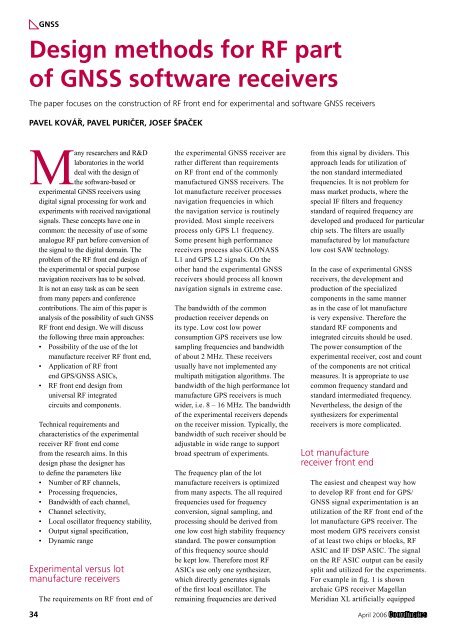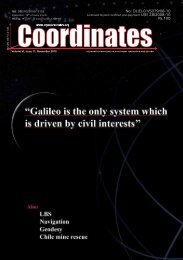Download - Coordinates
Download - Coordinates
Download - Coordinates
You also want an ePaper? Increase the reach of your titles
YUMPU automatically turns print PDFs into web optimized ePapers that Google loves.
GNSS<br />
Design methods for RF part<br />
of GNSS software receivers<br />
The paper focuses on the construction of RF front end for experimental and software GNSS receivers<br />
PAVEL KOVÁR, PAVEL PURICER, JOSEF ŠPACEK<br />
Many researchers and R&D<br />
laboratories in the world<br />
deal with the design of<br />
the software-based or<br />
experimental GNSS receivers using<br />
digital signal processing for work and<br />
experiments with received navigational<br />
signals. These concepts have one in<br />
common: the necessity of use of some<br />
analogue RF part before conversion of<br />
the signal to the digital domain. The<br />
problem of the RF front end design of<br />
the experimental or special purpose<br />
navigation receivers has to be solved.<br />
It is not an easy task as can be seen<br />
from many papers and conference<br />
contributions. The aim of this paper is<br />
analysis of the possibility of such GNSS<br />
RF front end design. We will discuss<br />
the following three main approaches:<br />
• Possibility of the use of the lot<br />
manufacture receiver RF front end,<br />
• Application of RF front<br />
end GPS/GNSS ASICs,<br />
• RF front end design from<br />
universal RF integrated<br />
circuits and components.<br />
Technical requirements and<br />
characteristics of the experimental<br />
receiver RF front end come<br />
from the research aims. In this<br />
design phase the designer has<br />
to define the parameters like<br />
• Number of RF channels,<br />
• Processing frequencies,<br />
• Bandwidth of each channel,<br />
• Channel selectivity,<br />
• Local oscillator frequency stability,<br />
• Output signal specification,<br />
• Dynamic range<br />
Experimental versus lot<br />
manufacture receivers<br />
The requirements on RF front end of<br />
the experimental GNSS receiver are<br />
rather different than requirements<br />
on RF front end of the commonly<br />
manufactured GNSS receivers. The<br />
lot manufacture receiver processes<br />
navigation frequencies in which<br />
the navigation service is routinely<br />
provided. Most simple receivers<br />
process only GPS L1 frequency.<br />
Some present high performance<br />
receivers process also GLONASS<br />
L1 and GPS L2 signals. On the<br />
other hand the experimental GNSS<br />
receivers should process all known<br />
navigation signals in extreme case.<br />
The bandwidth of the common<br />
production receiver depends on<br />
its type. Low cost low power<br />
consumption GPS receivers use low<br />
sampling frequencies and bandwidth<br />
of about 2 MHz. These receivers<br />
usually have not implemented any<br />
multipath mitigation algorithms. The<br />
bandwidth of the high performance lot<br />
manufacture GPS receivers is much<br />
wider, i.e. 8 – 16 MHz. The bandwidth<br />
of the experimental receivers depends<br />
on the receiver mission. Typically, the<br />
bandwidth of such receiver should be<br />
adjustable in wide range to support<br />
broad spectrum of experiments.<br />
The frequency plan of the lot<br />
manufacture receivers is optimized<br />
from many aspects. The all required<br />
frequencies used for frequency<br />
conversion, signal sampling, and<br />
processing should be derived from<br />
one low cost high stability frequency<br />
standard. The power consumption<br />
of this frequency source should<br />
be kept low. Therefore most RF<br />
ASICs use only one synthesizer,<br />
which directly generates signals<br />
of the first local oscillator. The<br />
remaining frequencies are derived<br />
from this signal by dividers. This<br />
approach leads for utilization of<br />
the non standard intermediated<br />
frequencies. It is not problem for<br />
mass market products, where the<br />
special IF filters and frequency<br />
standard of required frequency are<br />
developed and produced for particular<br />
chip sets. The filters are usually<br />
manufactured by lot manufacture<br />
low cost SAW technology.<br />
In the case of experimental GNSS<br />
receivers, the development and<br />
production of the specialized<br />
components in the same manner<br />
as in the case of lot manufacture<br />
is very expensive. Therefore the<br />
standard RF components and<br />
integrated circuits should be used.<br />
The power consumption of the<br />
experimental receiver, cost and count<br />
of the components are not critical<br />
measures. It is appropriate to use<br />
common frequency standard and<br />
standard intermediated frequency.<br />
Nevertheless, the design of the<br />
synthesizers for experimental<br />
receivers is more complicated.<br />
Lot manufacture<br />
receiver front end<br />
The easiest and cheapest way how<br />
to develop RF front end for GPS/<br />
GNSS signal experimentation is an<br />
utilization of the RF front end of the<br />
lot manufacture GPS receiver. The<br />
most modern GPS receivers consist<br />
of at least two chips or blocks, RF<br />
ASIC and IF DSP ASIC. The signal<br />
on the RF ASIC output can be easily<br />
split and utilized for the experiments.<br />
For example in fig. 1 is shown<br />
archaic GPS receiver Magellan<br />
Meridian XL artificially equipped<br />
34 April 2006

















